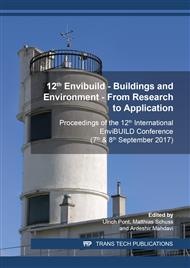[1]
H. Knötig. Human Ecology - The exact science of the interrelationships between Homo sapiens and the outside world surrounding this living and thinking being. The sixth meeting of the Society for Human Ecology Human Ecology: Crossing Boundaries,. Snowbird, Utah, USA,1992a.
Google Scholar
[2]
H. Knötig. Some essentials of the Vienna School of Human Ecology. Proceedings of the 1992 Birmingham Symposium; Austrian and British Efforts in Human Ecology. Archivum Oecologiae Hominis. Vienna, Austria, 1992b.
Google Scholar
[3]
A. Mahdavi. Approaches to Noise Control: A Human Ecological Perspective. Proceedings of the NOISE-CON 96 (The 1996 National Conference on Noise Control Engineering). Bellevue, WA, USA. p.649 – 654, 1996a.
Google Scholar
[4]
A. Mahdavi, A. The human factor in sustainable architecture. Low Energy Low Carbon Architecture: Recent Advances & Future Directions (Sustainable Energy Developments). Khaled A. Al-Sallal; Taylor & Francis, London, UK. ISBN: 978-1-138-02748-0, pp.137-158. (2016).
DOI: 10.1201/b19882-6
Google Scholar
[5]
A. Mahdavi. Human Ecological Reflections on the Architecture of the Well-tempered Environment,. In Proceedings of the 1996 International Symposium of CIB W67 (Energy and Mass Flows in the Life Cycle of Buildings). Vienna, Austria. (1996b) pp.11-22.
Google Scholar
[6]
J. Uexküll. Kompositionslehre der Natur. (Edited by Thure von Uexküll). Frankfurt am Main, (1920).
Google Scholar
[7]
J. Gibson. The Ecological Approach to Visual Perception, ISBN 0-89859-959-8, (1979).
Google Scholar
[8]
J. Gibson. The Theory of Affordances. In Perceiving, Acting, and Knowing, Eds. Robert Shaw and John Bransford, ISBN 0-470-99014-7, (1977).
Google Scholar
[9]
A. Mahdavi. A Human Ecological View of Traditional, Architecture. Human Ecology Review (HER). Volume 3, Number 1 (1996c) pp.108-114.
Google Scholar
[10]
A. Mahdavi. Traditionelle Bauweisen in wissenschaftlicher Sicht. Bauforum. Vol. 132 (1989) pp.34-40.
Google Scholar
[11]
A. Mahdavi. Acoustical Aspects of the Urban Environment. Aris; Journal of the Carnegie Mellon Department of Architecture. Volume 1 (1992) pp.42-57.
Google Scholar
[12]
A. Mahdavi. The human dimension of building performance simulation. Keynote: Building Simulation 2011 - IBPSA 2011, Sydney, Australia; (Soebarto V, Bennetts H, Bannister P, Thomas PC, Leach D.: Editors). ISBN: 978-0-646-56510-1 (2011a) pp. K16 - K33.
Google Scholar


